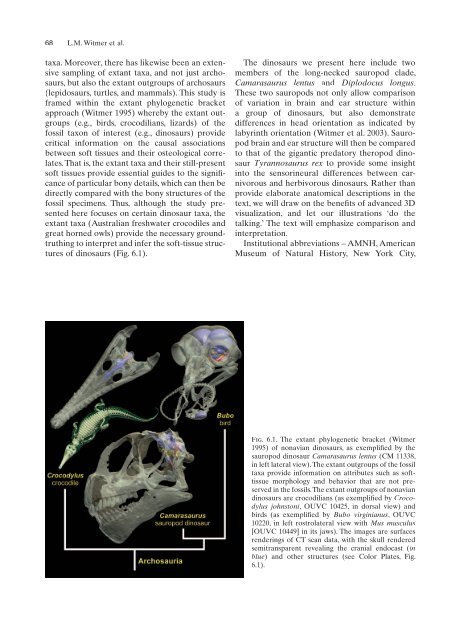Witmer, L. M., R. C. Ridgely, D. L. Dufeau, and M. C.
Witmer, L. M., R. C. Ridgely, D. L. Dufeau, and M. C.
Witmer, L. M., R. C. Ridgely, D. L. Dufeau, and M. C.
You also want an ePaper? Increase the reach of your titles
YUMPU automatically turns print PDFs into web optimized ePapers that Google loves.
68 L.M. <strong>Witmer</strong> et al.<br />
taxa. Moreover, there has likewise been an extensive<br />
sampling of extant taxa, <strong>and</strong> not just archosaurs,<br />
but also the extant outgroups of archosaurs<br />
(lepidosaurs, turtles, <strong>and</strong> mammals). This study is<br />
framed within the extant phylogenetic bracket<br />
approach (<strong>Witmer</strong> 1995) whereby the extant outgroups<br />
(e.g., birds, crocodilians, lizards) of the<br />
fossil taxon of interest (e.g., dinosaurs) provide<br />
critical information on the causal associations<br />
between soft tissues <strong>and</strong> their osteological correlates.<br />
That is, the extant taxa <strong>and</strong> their still-present<br />
soft tissues provide essential guides to the signififi<br />
cance of particular bony details, which can then be<br />
directly compared with the bony structures of the<br />
fossil specimens. Thus, although the study presented<br />
here focuses on certain dinosaur taxa, the<br />
extant taxa (Australian freshwater crocodiles <strong>and</strong><br />
great horned owls) provide the necessary groundtruthing<br />
to interpret <strong>and</strong> infer the soft-tissue structures<br />
of dinosaurs (Fig. 6.1).<br />
The dinosaurs we present here include two<br />
members of the long-necked sauropod clade,<br />
Camarasaurus lentus <strong>and</strong> Diplodocus longus.<br />
These two sauropods not only allow comparison<br />
of variation in brain <strong>and</strong> ear structure within<br />
a group of dinosaurs, but also demonstrate<br />
differences in head orientation as indicated by<br />
labyrinth orientation (<strong>Witmer</strong> et al. 2003). Sauropod<br />
brain <strong>and</strong> ear structure will then be compared<br />
to that of the gigantic predatory theropod dinosaur<br />
Tyrannosaurus rex to provide some insight<br />
into the sensorineural differences between carnivorous<br />
<strong>and</strong> herbivorous dinosaurs. Rather than<br />
provide elaborate anatomical descriptions in the<br />
text, we will draw on the benefits fi of advanced 3D<br />
visualization, <strong>and</strong> let our illustrations ‘do the<br />
talking.’ The text will emphasize comparison <strong>and</strong><br />
interpretation.<br />
Institutional abbreviations – AMNH, American<br />
Museum of Natural History, New York City,<br />
Fig. 6.1. The extant phylogenetic bracket (<strong>Witmer</strong><br />
1995) of nonavian dinosaurs, as exemplified fi by the<br />
sauropod dinosaur Camarasaurus lentus (CM 11338,<br />
in left lateral view). The extant outgroups of the fossil<br />
taxa provide information on attributes such as softtissue<br />
morphology <strong>and</strong> behavior that are not preserved<br />
in the fossils. The extant outgroups of nonavian<br />
dinosaurs are crocodilians (as exemplified fi by Crocodylus<br />
johnstoni, OUVC 10425, in dorsal view) <strong>and</strong><br />
birds (as exemplified fi by Bubo virginianus, OUVC<br />
10220, in left rostrolateral view with Mus musculus<br />
[OUVC 10449] in its jaws). The images are surfaces<br />
renderings of CT scan data, with the skull rendered<br />
semitransparent revealing the cranial endocast (in<br />
blue) <strong>and</strong> other structures (see Color Plates, Fig.<br />
6.1).

















